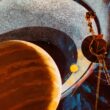NASA’s first RPG
Revealing the Story of NASA’s First Tabletop Role-Playing Game: Going Beyond Rockets and Rovers
When one thinks about NASA’s voyage, images usually come to mind: astronauts stepping out into the unknown, rovers scouring Martian terrain, and enormous rockets bursting through the atmosphere. But the agency’s influence goes beyond the domain of hard research and into the creative sphere of roleplaying games on a tabletop (RPGs). The Lost Universe, their first formal entry into this field, has taken a lot of people by surprise with its intriguing plot and distinctive mythos.
Table of Contents

The Lost Universe’s Setting: A Mystery World Awaits
NASA’s first RPG
Players of The Lost Universe visit the city of Aldastron on the rogue planet Exlaris. This mysterious metropolis is facing a crisis brought on by a malevolent power that endangers its citizens. The objective for players is to uncover the mysteries surrounding this impending menace and bring peace back to Aldastron. Players assume the role of daring explorers, each with their own special talents and powers.
Even though the location is made up, it deftly blends aspects of scientific research and space travel. Though a rogue planet, Exlaris has a distinct environment and a variety of strange lifeforms that pique players’ curiosity and entice them to explore their surroundings.
Cracking the Code: The Tale and the Play
NASA’s first RPG
The Lost Universe’s narrative develops gradually as players take on missions, overcome obstacles, and communicate with non-player characters (NPCs). In order to overcome challenges and solve the main mystery, players must cooperate in this cooperative game that promotes problem-solving.
Here are a few crucial gameplay elements:
NASA’s first RPG
- Character Creation: Players can make their own characters by modifying their skills and abilities to fit their desired playstyle, or they can select from a variety of pre-designed characters.
- Exploration and Discovery: The game environment gives players the chance to travel to other parts of Aldastron, where they can find clues, speak with NPCs, and acquire knowledge that will help the plot develop.
- Action and Combat: As players progress through the game, they will face difficulties and roadblocks that occasionally force them to use their character’s special talents and powers to fight.
- Adaptability and Flexibility: To accommodate a range of player preferences and offer flexibility, the game system lets players use the tabletop role-playing game system of their choice.
There is more to The Lost Universe than just rolling dice and slaying monsters. It involves teamwork, analytical reasoning, and narrative. In addition to discovering Aldastron’s mysteries, gamers who immerse themselves in the enigma learn more about scientific ideas and problem-solving methods.
Beyond the Game: The Lost Universe’s Significance
NASA’s first RPG
The Lost Universe’s release is a major milestone for NASA. It indicates the agency’s dedication to:
- Engaging a Wider Audience: The game appeals to a broad audience due to its accessible format, free downloadable resources, and compatibility with a variety of role-playing game systems. It has the potential to pique the interest of people who might not normally interact with traditional STEM-related materials in science and space exploration.
- Encouraging Creativity and Problem-Solving: The storyline of the game and its open-ended design foster collaborative problem-solving, critical thinking, and creative thinking in players—all of which are necessary for future scientists and inventors.
- Motivating the Upcoming Generation: NASA is attempting to stimulate young minds and foster a passion for science and space travel by entering the tabletop role-playing game market. The Lost Universe provides a forum for piqueing interest in the grandeur of the cosmos and kindling imaginations.
NASA’s first RPG
Though unexpected, The Lost Universe presents a novel viewpoint on how NASA may engage the general people. It’s evidence of the organization’s commitment to promoting scientific inquiry through innovative missions, state-of-the-art technology, and artistic mediums such as tabletop games, ultimately motivating the following generation of scientists and dreamers.


